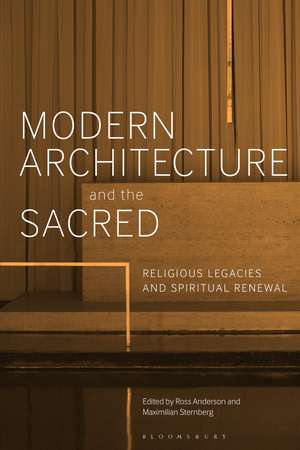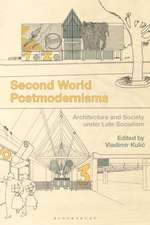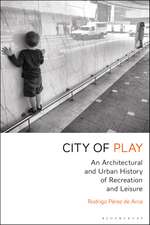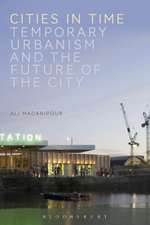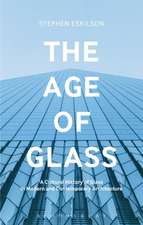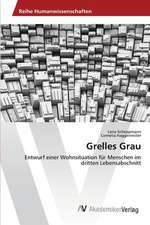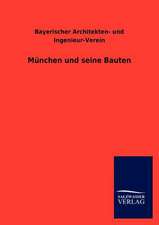Modern Architecture and the Sacred: Religious Legacies and Spiritual Renewal
Editat de Dr Ross Anderson, Dr Maximilian Sternbergen Limba Engleză Paperback – 9 feb 2022
| Toate formatele și edițiile | Preț | Express |
|---|---|---|
| Paperback (1) | 203.92 lei 3-5 săpt. | +58.72 lei 7-13 zile |
| Bloomsbury Publishing – 9 feb 2022 | 203.92 lei 3-5 săpt. | +58.72 lei 7-13 zile |
| Hardback (1) | 706.27 lei 3-5 săpt. | +28.88 lei 7-13 zile |
| Bloomsbury Publishing – 25 noi 2020 | 706.27 lei 3-5 săpt. | +28.88 lei 7-13 zile |
Preț: 203.92 lei
Preț vechi: 233.91 lei
-13% Nou
Puncte Express: 306
Preț estimativ în valută:
39.02€ • 40.74$ • 32.29£
39.02€ • 40.74$ • 32.29£
Carte disponibilă
Livrare economică 14-28 martie
Livrare express 28 februarie-06 martie pentru 68.71 lei
Preluare comenzi: 021 569.72.76
Specificații
ISBN-13: 9781350294356
ISBN-10: 1350294357
Pagini: 304
Ilustrații: 96 bw illus
Dimensiuni: 156 x 234 x 21 mm
Greutate: 0.65 kg
Editura: Bloomsbury Publishing
Colecția Bloomsbury Visual Arts
Locul publicării:London, United Kingdom
ISBN-10: 1350294357
Pagini: 304
Ilustrații: 96 bw illus
Dimensiuni: 156 x 234 x 21 mm
Greutate: 0.65 kg
Editura: Bloomsbury Publishing
Colecția Bloomsbury Visual Arts
Locul publicării:London, United Kingdom
Caracteristici
Makes an important re-evaluation of a long-marginalized aspect of modern architecture, illuminating the often unspoken or underplayed spiritual motivations of architects designing ostensibly secular buildings that on close reading in fact reveal sacred aspirations
Notă biografică
Ross Anderson is an Associate Professor of Architecture at the University of Sydney, Australia.Maximilian Sternberg is a University Senior Lecturer in Architecture and Fellow of Pembroke College at Cambridge University, UK.
Cuprins
List of figuresNotes on contributorsAcknowledgementsIntroduction, Ross Anderson (University of Sydney, Australia) and Maximilian Sternberg (University of Cambridge, UK)Part One Beginnings and transformations of the modern sacred 1. Architecture and the question of 'the' sacred, Peter Carl (University of Cambridge, UK)2 Romantic Kunstreligion and the search for the sacred in modern architecture: From Schinkel's Altes Museum as 'aesthetic church' to Zumthor's Bruder Klaus Field Chapel as Gesamtkunstwerk and 'heavenly cave', Gabriele Bryant (Independent Scholar)3. The Ordinary as the extraordinary: Modern sacred architecture in Germany, the United States and Japan, Kathleen James-Chakraborty (University College Dublin, Ireland)4. Città dei Morti: Alvar Aalto's funerary architecture, Sofia Singler (University of Cambridge, UK)Part Two Buildings for modern worship5. Light, form and formación: Daylighting, church building and the work of the Valparaíso School, Mary Ann Steane (University of Cambridge, UK)6. Reading, storing and parading the book: Between tradition and modernity in the synagogue, Gerald Adler (University of Kent, UK)7. Compacting civic and sacred: Goodhue's University of Chicago Chapeland the modern metropolis, Stephen Gage (University of Reading, UK)8. A diaspora of modern sacred form: Auguste Perret, Le Corbusier and Paul Valéry, Karla Cavarra Britton (Diné College, Navajo Nation)9. Structure for spirit in The Architectural Review and The Architects' Journal, 1945-70, Sam Samarghandi (Independent Scholar, Australia)Part Three Semi-sacred settings in the cultural topography of modernity 10. Revelatory earth: Adolphe Appia and the prospect of a modern sacred, Ross Anderson (University of Sydney, Australia)11. Anagogical themes in Schwitters' Kathedrale des erotischen Elends, Matthew Mindrup (University of Sydney, Australia)12. Modern medievalisms: Curating the sacred at the Schnütgen Museum in Cologne (1932-9), Maximilian Sternberg (University of Cambridge, UK)13. Architecture, politics and the sacred in military monuments of Fascist Italy, Hannah Malone (Max Planck Institute, Germany)14. Atmosphere of the sacred: The awry in music, cinema, architecture, Michael Tawa (University of Sydney, Australia)BibliographyIndex
Recenzii
As religiosity declined in the West, architecture became the bearer of a powerful secular spirituality, widely ignored in the standard histories. In its broad and inclusive approach, this volume argues persuasively that the pursuit of the sacred was a key constituent of 20th-century architectural design and theory: a revision long overdue.
